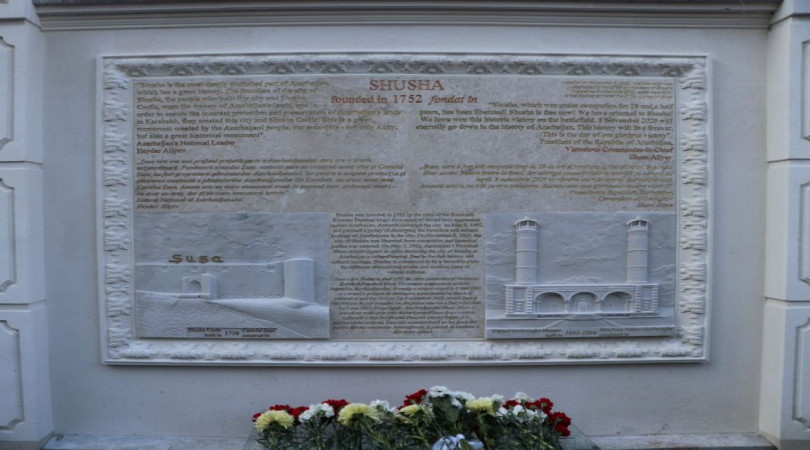Nizami Genjevi
Nizami Genjevi
(1140-1209)
Nizami Ilyas the son of Yusif is a great master of words and philosopher of the XII century culture of Renaissance. He was born, got his education, and created in old Ganja, situated on 'ipek yolu' the way of silk, along which the eastern and the western culture are mixed. In the XI century, being the center of Aran, it was a city of highly developed culture, with a state palace, medrese, medical and scientific institutions. It was also the center of education in literature, history, philosophy, astrology, mathematics, and the religious sciences.
The first biographical information about Nizami's personality was recorded 300 years after his passing away, thus there is no exact information about his age, the dates of his birth and death, about his visits, his parents, and relatives. So the information given about him is only the supposition of the scientists. Nizami mentioned himself, his father, grandfather, and his mother.
Alike his predecessors and contemporaries Nizami started his activity by writing gazals and qasidas. Being unsatisfied with it he inclined to create his work in the genre of epic novel-epos, extending since the XI century after Firdovsi. His first attempt in this direction was created about his forties "Makhzanul-asrar", the original pattern of epic couplet genre of the XII century. The work is characterized as a combination of the tale the epos in belles-lettres. The tales and the eposes reflect the major features of the epic genre-language, devices and the context of the belles-lettres. The mesnevi (couplet) contains 13 eposes and 7 stories. As a rule, the eposes and the stories followed the articles and decoded and gave an artistic analysis of their philosophical and ethical significance and the symbols.
"Makhzanul-asrar" ('The treasure of secrets') begins with tovhi and minacat, and forewords about praising and Ascension of the Prophet. It tells about the origin and the essence of Allah, that he is single, he is the creator, he is the inventor and the beginning of everything, he appointed Muhammed excellency (s) to be a prophet to accept and to represent Him, also about Gurani-Kerim (Koran) sent to the Prophet as a book of knowledge for Moslems, etc. there is an essential-contextual relation between the artistic parts of the book and the forewords, time-to-time ayes of Koran are mentioned here. Thus 'The treasure of secrets' can be named a complete Islamic literary work about the world, a perfect man, and a perfect society.
The second work of Nizami 'Khosrov and Shirin' was written in 1180 and dedicated to Jahan Pahlavan, the ruler of Azerbaijan. Though the theme of the work is about the history of pre-Islamic Iran, the poet used a verse different from Firdovsi. Alike the literary works of 'Khamsa' 'Khosrov and Shirin' begins with minacat, praising and Ascension of the Prophet, addresses to the king. In the part of the book where the poet tells about its creation, he also gives the philosophical characteristics of love, here described. He calls it cosmic love and: 'there is no other mehrab of the destiny as love…, the world is (completely full of ) the love'. As to him if love falls on to the heart of the stone, it will attract the inner jewellery of it. It is the love that draws iron to a magnet.' With these words, Nizami wished to see beautifully described universal and real love in the hearts of Turan and Iran expressing his wish indirectly by the personages of Khosrov and Shirin. The poet made a hint describing Shirin as a princess of Turan from the family of Afrasiyab. He had a political aim in presenting all abovementioned to the state of Atabeys.
In this literary work, Nizami tries to solve social-political problems by means of love and moral evolution, but orgy and voluptuousness of Khosrov brings a great obstacle in front of him; he has been killed by his son Shiruya, as in saying 'The ash is the son of the fire'("Odun oglu kul olar") Coming to a philosophical conclusion poet points to the periodicity of natural life and says:'Realise yourself to recognize the reality with density, if so, in spite of far distance the destiny is like a mirror in front of you. You are made of two worlds.' Nizami states that though a human body may be perfect in the four elements, he should avoid the characters and the differences of those elements. He gives examples of natural events and calls a man to moral-sensitive evolution and to avoid physical pleasures. In the face of a naturalist, Nizami tries to solve social problems with natural philosophy.
'Khosrov and Shirin' is an original pattern also for literary- artistic structure and the style. The competition between Khosrov and Shirin and reading of gazals by Barbet and Nakisa under musical accompaniment praising the heroes prove that the philosophy of life is reflected in the relation of music and poetry.
The subject of 'Leyli and Mejnun' written by Nizami in 1188, with the request of Shirvanshah Akhsitan, had been taken from pre-Islamic Arabic folk-lore, the central subject is the nature of Arabia and the life of badavies. The poet tried to show processes that platonic love in the lives of tribes carried in the period of Islam. While the center of translation and investigation founded in Bagdad in the VIII century spread the ancient and old Greek literary-philosophical works, rabis in the IX-X centuries showed great interest toward the love adventures of Mejnun and Leyli and gathered their rayets. The process of Islamisation mentioned in stories happened during this period.
In the Islamic period, social ethics found it to be humiliating and unpermittable to manifest love gazals, but the uluhiyyet of love in the life of uzries denies any kind of prohibitions. This is named wandering or 'madness' in Islam. Nizami explains love from the aspect of Renaissance philosophy, to be the main rule of life and says there is no opposition to this love. Majnun sees love in Kaba, in the desert, in the sky, and ask Kaba and the stars to help his love.
The natural love of Mejnun files for it could not pass the obstacles crested by tribal traditions. The main attention in the literary work is paid to deep contradictions of innovation, new life, and the sense of the renaissance with antiquity and ignorance which was so peculiar at the beginning of the Renaissance.
In foreword of this poem, Nizami criticizes Akhsitan's idea to rich the epic with Arabic-Persian words and to avoid Turkish elements and character. He names Leyli and Mejnun the Turks with Turkish language living among the Arabians. The abovementioned thoughts were the characteristic features of the XII century Azerbaijan renaissance.
The epic ''Heft Peyker' ('the seven beauties') written by Nizami in 1197 is dedicated to the ruler of Maraga Agsungur Korpe Arslan, alike Leyli and Mejnun', is a work of the renaissance the theme of which is taken from the history of the dynasty of Sasani rulers. The plot of the epic is based on love, social life, and statehood of the VIII-X century when Midiya-Greek literary-philosophical cultures synthesized in the period of Islamic renaissance. The love described in the epic is alike that of between 'Khosrov and Shirin', 'Leyli and Mejnun', i.e. cosmic-world. This love as to its nature creates peace and equality between the parties and destroys all the excited contradictions.
In the given epic the cosmos is established in the Earth in the pattern of seven domes. Each of these domes, symbolizing seven planets for their particular color and character are adapted to the character and the deeds of human inner and other body-members and thus reveal the beauties and the faults of human ethics. According to this conception, for its origin, a human is the combination of perceptible(material) and mental (moral-spiritual or mental-passionate) worlds.
"Faziletli adamların sheheri' by Farabi greatly influenced the poet for the creation of 'Seven Beauties' ("Yeddi gozel"). In the former, the body was compared with a city, a country. The conception of antic Zoroastric and Greek natural-philosophical ides found their literary reflection in this epic.
'Isgendername', supposed to be written in 1200-1203 was dedicated to his dear Nusrateddin Abubekr, by the writer's own wish. The theme of this work also was taken from the history of Iran-Greek wars. This is the main peculiarity of the East renaissance.
The aim of Nizami in this work is not the description of the wars, but the introduction of eastern culture to the greek and thereby the synthesis of the two cultures. When Iskender burnt Iranian teshkeders, the philosophers around him insisted that he should take the texts of 'Avesta' written on the leather, send them to Greece and translate and learn them. Greek scientists confirm that antic greek scientists studied and used the natural-philosophical conceptions of the mugs and. As Nizami writes, Iskender looks upon the real events related to the culture and the society absent in his motherland as the miracle of life. He meets different countries, people, and cultures along his way, gets acquainted with the school of Indian charbaks, arrive to the diamond field on his way back to the north, the soldiers gather the pieces of the diamond with them. The most important cultural point of the work is Iskender's presentation in the country without ahead'. He admired the life, thinking, the system of ruling based on equality in this country. Iskender hears about the water of life in the northern darkness and tried to find a way there. The search of sources of eternity existed in the ancient cultures; in shumer epics. This source, in Shumer epic, is shown in the east, possible on the islands of the Caspian lake of the lake Urmu. The aborigen of the island Uminanitdin knows the way out. According to Zoroastric traditions, the source of eternity is the plant 'Hoym".
Iskender on his way to the darkness with the Prophet Khizir, losses his way, Khizir finds the water of eternity, drinks it, and informs Iskender about it.
Thus Iskender gets the opportunity of prophecy, the pick of mental evolution, not in Greece, but after getting acquainted with the culture, scientific-philosophical world outlook of the east during his trip. According to this aspect "Iskendername" is the final completed work of renaissance in the literary-philosophical creativity of Nizami.


















